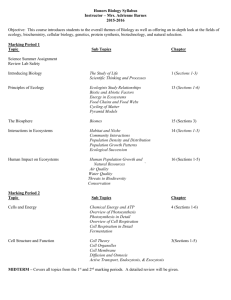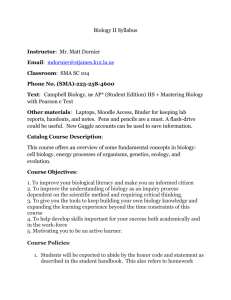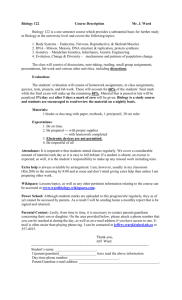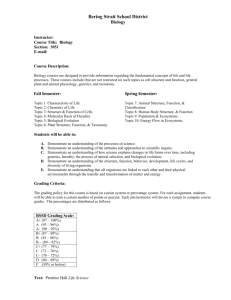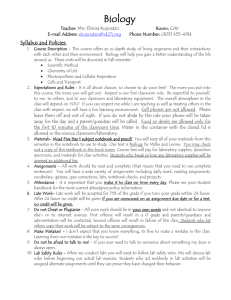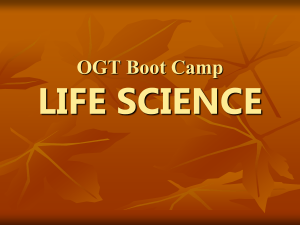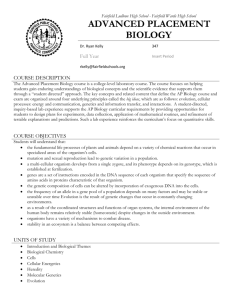CP Biology Syllabus
advertisement
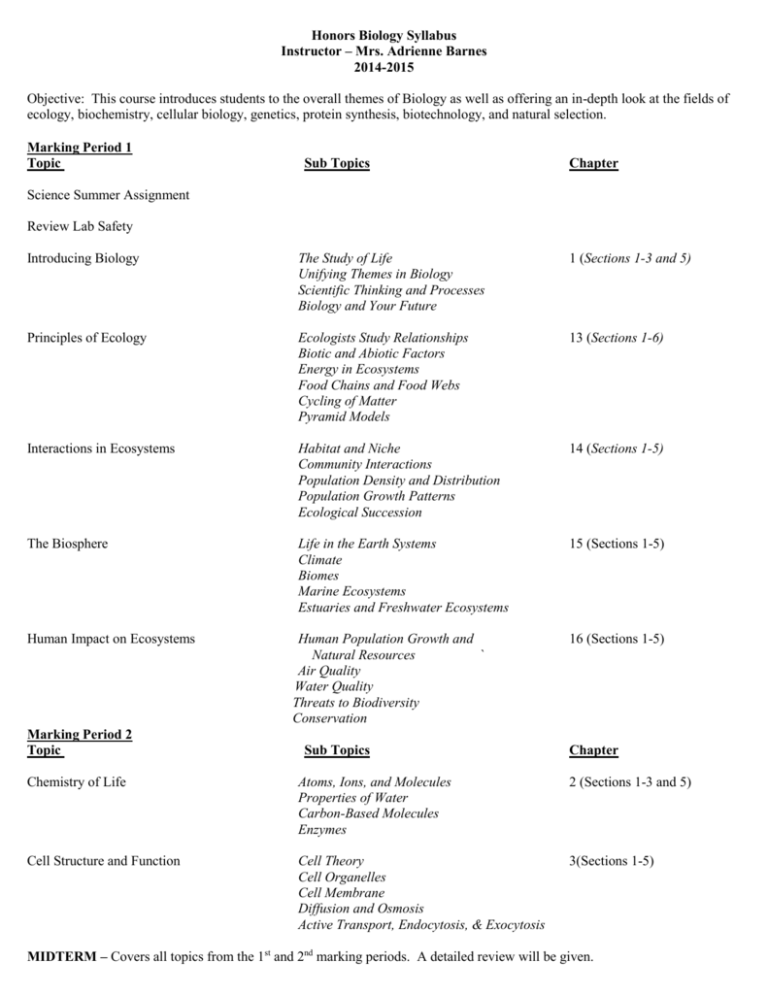
Honors Biology Syllabus Instructor – Mrs. Adrienne Barnes 2014-2015 Objective: This course introduces students to the overall themes of Biology as well as offering an in-depth look at the fields of ecology, biochemistry, cellular biology, genetics, protein synthesis, biotechnology, and natural selection. Marking Period 1 Topic Sub Topics Chapter Science Summer Assignment Review Lab Safety Introducing Biology The Study of Life Unifying Themes in Biology Scientific Thinking and Processes Biology and Your Future 1 (Sections 1-3 and 5) Principles of Ecology Ecologists Study Relationships Biotic and Abiotic Factors Energy in Ecosystems Food Chains and Food Webs Cycling of Matter Pyramid Models 13 (Sections 1-6) Interactions in Ecosystems Habitat and Niche Community Interactions Population Density and Distribution Population Growth Patterns Ecological Succession 14 (Sections 1-5) The Biosphere Life in the Earth Systems Climate Biomes Marine Ecosystems Estuaries and Freshwater Ecosystems 15 (Sections 1-5) Human Impact on Ecosystems Marking Period 2 Topic Human Population Growth and Natural Resources ` Air Quality Water Quality Threats to Biodiversity Conservation Sub Topics 16 (Sections 1-5) Chapter Chemistry of Life Atoms, Ions, and Molecules Properties of Water Carbon-Based Molecules Enzymes 2 (Sections 1-3 and 5) Cell Structure and Function Cell Theory Cell Organelles Cell Membrane Diffusion and Osmosis Active Transport, Endocytosis, & Exocytosis 3(Sections 1-5) MIDTERM – Covers all topics from the 1st and 2nd marking periods. A detailed review will be given. Marking Period 3 Topic Sub Topics Chapter Cells and Energy Chemical Energy and ATP Overview of Photosynthesis Photosynthesis in Detail Overview of Cell Respiration Cell Respiration in Detail Fermentation 4 (Sections 1-6) Cell Growth and Division The Cell Cycle Mitosis and Cytokinesis Regulation of the Cell Cycle Asexual Reproduction Multicellular Life 5 (Sections 1-5) Meiosis and Mendel Chromosomes and Meiosis Process of Meiosis Mendel and Heredity Traits, Genes, and Alleles Traits and Probability Meiosis and Genetic Variation 6 (Sections 1-6) Extending Mendelian Genetics Chromosomes and Phenotype Complex Patterns of Inheritance Gene Linkage and Mapping Human Genetics and Pedigrees 7 (Sections 1-4) Marking Period 4 Topic Sub Topics Chapter From DNA to Protein Identifying DNA as the Genetic Material Structure of DNA DNA Replication Transcription and Translation Mutations 8 (Sections 1-5 and 7) Frontiers of Biotechnology Manipulating and Copying DNA DNA Fingerprinting Genetic Engineering Human Genome Project Genetic Screening and Gene Therapy 9 (Sections 1-6) Introduction to Evolution Early Ideas About Evolution Darwin’s Observations Theory of Natural Selection Evidence of Evolution 10 (Sections 1-4) The Evolution of Populations Speciation through Isolation Patterns in Evolution 11 (Sections 5 & 6) The History of Life Origin of Life Early Single-Celled Organisms 12 (Section 3 & 4) The Tree of Life The Linnaean System of Classification Classification Based on Evolutionary Relationships Domains and Kingdoms 17 (Sections 1, 2, & 4) **Review for End of Course Biology Exam Viruses and Prokaryotes Viral Structure and Reproduction Viral Diseases Bacteria and Archaea Beneficial Roles of Prokaryotes Bacterial Diseases and Antibiotics 18 (Sections 2-6) Comparative Anatomy Frog Dissection 32 (Section 2) FINAL EXAM - Covers all topics from the 3rd and 4th marking periods. A detailed review will be given. Textbook: Biology, Holt McDougal, 2012. Grading System: Your grade for this class will be based on tests, quizzes, labs, class participation, completion of class and homework assignments as well as the maintenance of a notebook. Please see the grading policy information below for further details. Class Participation and Class Assignments – 25% of Grade; as evidenced by completing the “Do Now” daily , completion of all class work assignments, asking and responding to questions, offering relevant comments, and respecting the teacher’s authority. Preparedness – your binder, pen or pencil and agenda must be in class EVERYDAY! Homework Assignments – 20% of Grade Laboratory Assignments - 25% of Grade Tests/Quizzes - 30% of Grade; includes all tests, quizzes, and projects. Notebook checks will count as test grades.
